
Air-Purifying Qualities: EXCELLENT
Excellent at removing formaldehyde and xylene.
Care: EASY +
Prefers bright, indirect sunlight and well-drained soil. Tolerant of occasional neglect.
The Spider Plant, scientifically known as Chlorophytum comosum, is a perennial favorite among houseplant enthusiasts. It's particularly renowned for its air-purifying qualities and easy-to-grow nature. The plant is characterized by its grass-like leaves, which are often striped with white, and its unique ability to produce baby plants, or "spiderettes," which dangle from the mother plant.
Light Requirements: Spider Plants prefer bright, indirect light but can tolerate lower light levels. Direct sunlight might scorch the leaves, so it’s best to avoid placing them in a spot where they’ll receive harsh afternoon sun. Inadequate light can cause the variegation in the leaves to fade.
Watering: They like their soil to be kept evenly moist but not soggy. Water the plant when the top inch of soil feels dry to the touch. Spider Plants are somewhat drought tolerant and are more susceptible to damage from overwatering than underwatering.
Soil and Potting: Use a well-draining potting mix. They are not particularly fussy about soil as long as it allows for good drainage. Repotting every couple of years, or when the plant becomes root-bound, is sufficient. Ensure the pot has drainage holes.
Temperature and Humidity: Spider Plants prefer average room temperatures between 60-75°F (15-24°C) and can tolerate a wide range of humidity levels. They enjoy a bit of humidity but will do just fine in drier environments as well.
Fertilizing: Feed with a balanced, water-soluble fertilizer about once a month during the growing season (spring and summer). Reduce feeding in the fall and winter months.
Pruning and Maintenance: Pruning is not often necessary, but you can trim off brown leaf tips or remove dead leaves as needed. Regularly removing the spiderettes can encourage more foliage growth on the main plant.
Air Purifying: Spider Plants are excellent at purifying indoor air by removing toxins such as formaldehyde and xylene, making them a healthy choice for home and office settings.
Propagation: One of the most fun aspects of the Spider Plant is its ease of propagation. The spiderettes can be easily rooted in water or soil to create new plants.
General Care Tips: Spider Plants are known for being particularly forgiving and adaptable, making them a great choice for novice gardeners or those with less-than-green thumbs.
In summary, the Spider Plant is an excellent houseplant for those looking for an easy-to-care-for, air-purifying, and visually appealing option. Its resilience and straightforward maintenance requirements make it a popular and satisfying choice for both beginners and experienced plant enthusiasts.

Air-Purifying Qualities: EXCELLENT
Known for filtering out formaldehyde, trichloroethylene, benzene, xylene, and toluene. Uniquely, it releases oxygen at night.
Care: EASY +
Very low maintenance; thrives in low light and requires infrequent watering.
The Snake Plant, also known as Sansevieria or Mother-in-Law's Tongue, is a resilient and striking houseplant, prized for its architectural foliage and exceptional tolerance to neglect. Its upright, sword-shaped leaves, which can be dark green, variegated, or striped, make it a favorite for adding a modern touch to interior spaces.
Light Requirements: Snake Plants are highly adaptable in terms of light. They can thrive in bright, indirect sunlight but also do well in low-light conditions. Even though they are tolerant of dimmer areas, they prefer some natural light to maintain their color and vigor. Direct sunlight should be avoided as it can cause the leaves to fade.
Watering: This plant is drought-tolerant, requiring minimal watering. Overwatering is a common mistake and can lead to root rot. Water only when the soil is dry, typically every few weeks, depending on the humidity and light conditions. In winter, reduce watering further.
Soil and Potting: Use a well-draining potting mix, preferably one formulated for cacti and succulents. Good drainage is crucial to prevent water accumulation. Repotting is infrequent, only necessary when the plant becomes root-bound or the soil appears depleted.
Temperature and Humidity: Snake Plants prefer average room temperatures (between 60-75°F or 15-24°C) and will tolerate a wide range of humidity levels. However, they do not tolerate cold drafts well, so it's best to keep them away from drafty windows in the winter.
Fertilizing: Fertilize with a general-purpose houseplant fertilizer at half strength a few times a year during the growing season. Over-fertilization is not necessary and can be harmful.
Air Purifying: Known for their air-purifying abilities, Snake Plants can remove toxins such as formaldehyde and benzene from the air, making them a healthy addition to any indoor space.
General Care Tips: Snake Plants are incredibly low-maintenance, making them ideal for busy or forgetful owners. They're resistant to pests and diseases, although it's still a good idea to watch for common houseplant pests.
Toxicity: It's important to note that Snake Plants are toxic if ingested, so they should be kept away from pets and children.
In summary, the Snake Plant is a top choice for anyone looking for a hardy, low-maintenance houseplant that also improves indoor air quality. Its striking appearance and adaptability to a range of environmental conditions make it a popular and rewarding choice for indoor gardeners of all levels.
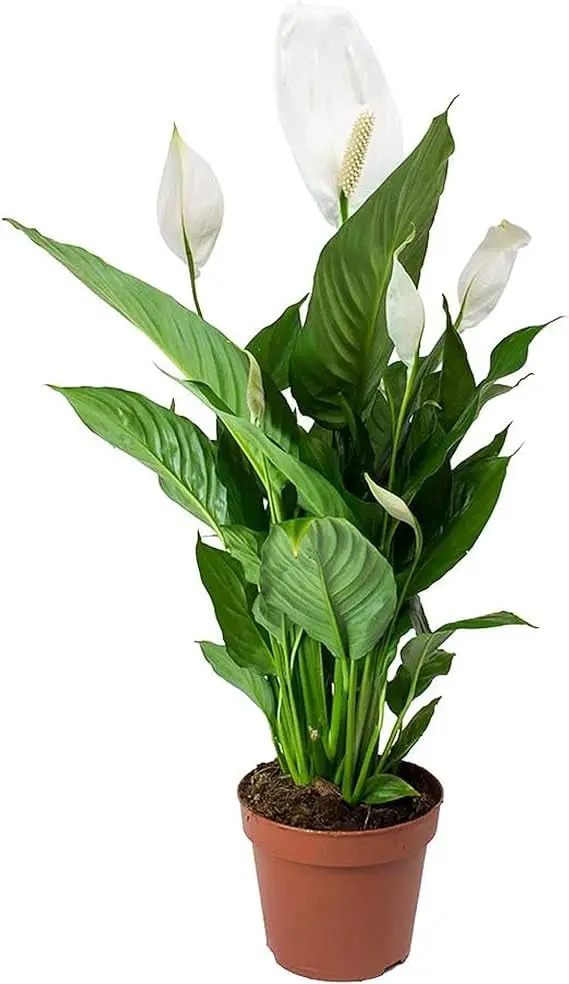
Air-Purifying Qualities: EXCELLENT
Reduces levels of mold spores, formaldehyde, and other toxins.
Care: WEEKLY
Prefers shady areas and needs to be kept moist without overwatering. Be mindful of its toxic nature to pets and children if ingested.
The Peace Lily (Spathiphyllum) is a beloved houseplant, admired for its lush green leaves and elegant white blooms. It's not only aesthetically pleasing but also known for its air-purifying capabilities, making it a popular choice for indoor environments.
Light and Location: Peace Lilies prefer bright, indirect light. They can tolerate low-light conditions, but too little light may prevent them from flowering. Avoid placing them in direct sunlight, as this can scorch their leaves. A spot near a window with sheer curtains is ideal to provide filtered light.
Watering: Keeping the soil consistently moist is key to caring for a Peace Lily. They are sensitive to overwatering and underwatering. Water them when the top inch of soil feels dry. If the leaves droop, it's a sign they need water, but be cautious not to let them sit in water, as this can lead to root rot.
Humidity and Temperature: Peace Lilies thrive in high humidity environments and average room temperatures. If the air is too dry, their leaf tips may brown. You can increase humidity by misting the leaves, placing a humidifier nearby, or using a pebble tray with water.
Soil and Fertilization: Use a well-draining, rich potting mix. Fertilize your Peace Lily with a balanced, water-soluble fertilizer every 6-8 weeks during the growing season, but avoid over-fertilization, which can harm the plant.
Flowering: The white flowers, or spathes, usually appear in the spring. After flowering, remove the spent blooms to encourage new growth.
Repotting: Peace Lilies should be repotted every few years or when they become root-bound. This is also a good opportunity to divide them for propagation.
Air Purifying: Known for removing toxins like formaldehyde and ammonia from the air, they are a healthy addition to any indoor space.
Overall, the Peace Lily is an excellent choice for those looking to add a touch of elegance and greenery to their indoor environment. Its relatively easy care and air-cleaning properties make it a popular and rewarding choice for indoor gardeners.

Air-Purifying Qualities: EXCELLENT
Helps remove formaldehyde and benzene.
Care: EASY -
Requires a lot of sun and occasional watering. Its leaves also contain a soothing gel that can be used for cuts and burns.
Aloe Vera, scientifically known as Aloe barbadensis miller, is a succulent plant renowned for its medicinal properties, especially its gel, which is used for soothing skin irritations and burns. This plant is also appreciated for its architectural form and is an easy-to-grow option for indoor gardeners.
Light Requirements: Aloe Vera thrives in bright, indirect sunlight. It can tolerate some direct sunlight, but too much can cause the leaves to brown and dry out. A south or west-facing window with filtered light is ideal. In low light conditions, its growth may be stunted.
Watering: Aloe Vera plants are drought-tolerant and prefer to be watered infrequently. The key is to let the soil dry out completely between waterings. Overwatering can lead to root rot, which is the most common issue with these plants. During the winter, water even less frequently.
Soil and Potting: Use a well-draining potting mix, ideally one formulated for cacti and succulents. Ensuring good drainage is critical, so choose a pot with drainage holes. Aloe Vera does not need to be repotted often, only when it becomes root-bound.
Temperature and Humidity: This plant prefers warm temperatures and does not tolerate frost. Keep it in a room with average room temperatures and protect it from drafts. Aloe Vera does not require high humidity and adapts well to the typical dry air found in homes.
Fertilizing: Fertilization is not a high priority for Aloe Vera, but if you choose to fertilize, do so sparingly. Use a diluted, balanced fertilizer once a year in the spring.
Propagation: Aloe Vera produces offsets or “pups” that can be separated from the mother plant and potted independently. This is an easy way to propagate new plants.
Medicinal Use: The gel inside the leaves is used for soothing minor cuts, burns, and skin irritations. To use, cut a leaf and apply the fresh gel to the affected area.
General Care: Aloe Vera is a low-maintenance plant, making it ideal for busy or forgetful gardeners. It’s important to monitor for overwatering and to provide adequate light to keep the plant healthy and thriving.
In summary, Aloe Vera is not only beneficial for its medicinal uses but also adds a decorative touch to the home. Its ease of care, combined with health benefits, makes it a must-have in any collection of houseplants.
1. Improved Air Quality:
Reduced Toxin Levels: Plants like Spider Plants and Peace Lilies can absorb harmful toxins like formaldehyde, benzene, and trichloroethylene, common in household cleaning products, paints, and furnishings.
Increased Humidity: Plants release moisture into the air through a process called transpiration, which helps in maintaining healthy indoor humidity levels. This is especially beneficial during dry seasons or in air-conditioned rooms where dry air can irritate the skin, eyes, and respiratory tract.
2. Enhanced Mental Health:
Stress Reduction: Studies have shown that the presence of greenery indoors can reduce stress and anxiety levels. The act of caring for plants can also be therapeutic and promote mindfulness.
Improved Mood and Productivity: The aesthetic appeal of plants can enhance mood, increase creativity, and even boost productivity, making them a great addition to home offices or workspaces.
3. Better Sleep Quality:
Oxygen Release at Night: Certain plants, like the Snake Plant, continue to release oxygen at night, unlike most plants that only do so during the day. This can improve air quality in bedrooms, potentially leading to better sleep quality.
4. Physical Health Improvements:
Reduced Incidence of Respiratory Problems: By filtering out airborne pollutants, plants can help reduce the risk of respiratory problems like asthma and allergic reactions.
Natural Healing: Some studies suggest that having plants in hospital rooms or recovery areas can speed up the healing process, reduce the need for painkillers, and decrease postoperative recovery times.
5. Improved Cognitive Function:
Enhanced Concentration and Memory: Being around plants and nature has been linked to improved concentration, memory retention, and cognitive function, possibly due to the reduced stress levels and cleaner air.
The presence of air-purifying plants in our living and working spaces offers a range of health benefits, from improving air quality to enhancing mental well-being. By integrating these natural elements into our daily environments, we not only beautify our spaces but also invest in our physical and mental health.
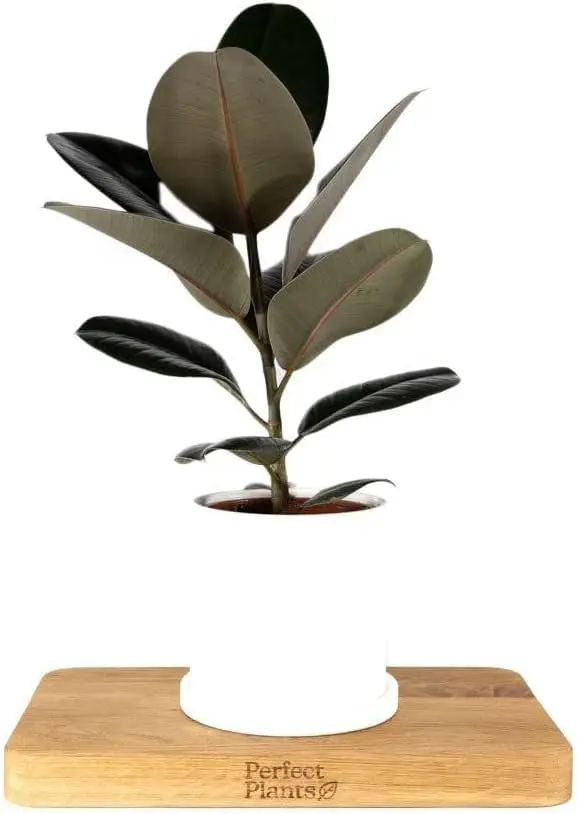
Air-Purifying Qualities: EXCELLENT
Effective at removing formaldehyde from the air.
Care: EASY +
Prefers indirect light and needs to be kept moist in growing season. Its large leaves may need occasional dusting.
The Rubber Plant, or Ficus elastica, is a robust and striking houseplant known for its glossy, dark green leaves and sturdy stature. It's a popular choice for interior decoration due to its bold appearance and air-purifying qualities.
Light Requirements: Rubber Plants prefer bright, indirect light. They can tolerate some direct morning sun but avoid intense afternoon sunlight, which can scorch the leaves. In low light, the plant will survive but may become leggy and lose its lustrous leaf color.
Watering: Water your Rubber Plant when the topsoil becomes dry to the touch, approximately every 1-2 weeks. Avoid overwatering, as this can lead to root rot. During the winter months, reduce watering as the plant enters a dormant phase.
Soil and Potting: Use a well-draining potting mix. Rubber Plants prefer to be slightly root-bound, so repotting every couple of years in spring is sufficient. Choose a pot with drainage holes to prevent water from accumulating at the bottom.
Temperature and Humidity: This plant enjoys average room temperatures between 60-75°F (15-24°C). It can tolerate lower temperatures but not below 50°F (10°C). Rubber Plants also prefer higher humidity but will adapt to average home humidity levels. You can increase humidity by misting the leaves, using a humidifier, or placing a pebble tray with water underneath the pot.
Fertilizing: Feed your Rubber Plant with a diluted, balanced liquid fertilizer once a month during the growing season (spring and summer). Reduce feeding in the fall and winter when the plant's growth slows down.
Pruning and Cleaning: Pruning can be done to shape the plant or control its size. Wipe the leaves with a damp cloth occasionally to remove dust and keep them glossy.
Toxicity: Be aware that the Rubber Plant is toxic if ingested, so it's important to keep it away from pets and children.
Propagation: Propagation can be done through air layering or by taking stem cuttings in the spring or early summer.
Overall, the Rubber Plant is a hardy and visually appealing houseplant that can add a touch of elegance to any indoor space. With its easy-care nature and air-purifying abilities, it's a great choice for both novice and experienced plant enthusiasts.
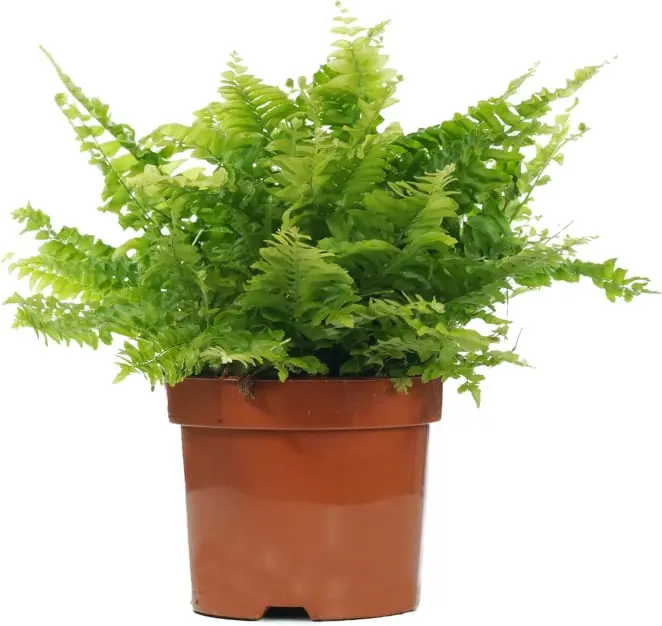
Air-Purifying Qualities: EXCELLENT
Great at removing formaldehyde and acting as a natural humidifier.
Care: WEEKLY
Thrives in high humidity and indirect light; requires regular misting and watering.
The Boston Fern, scientifically known as Nephrolepis exaltata 'Bostoniensis', is a lush, leafy plant renowned for its long, feathery fronds and classic elegance. This fern is popular in homes and offices for its air-purifying qualities and the vibrant green touch it adds to any space.
Light Requirements: Boston Ferns thrive in bright, indirect light. They can tolerate some morning sun but should be protected from harsh afternoon rays, which can scorch their delicate fronds. A north-facing or east-facing window is typically ideal. If the light is too low, the fronds may lose their lushness and become sparse.
Watering: Keeping the soil consistently moist is essential for Boston Ferns. They should be watered thoroughly whenever the top inch of soil feels dry. However, avoid waterlogging the soil, as this can lead to root rot. In drier environments, it's beneficial to provide additional humidity through misting or placing the pot on a tray filled with pebbles and water.
Humidity and Temperature: These ferns prefer high humidity and will thrive in a humid environment. If your home is dry, especially in winter, consider using a humidifier. Average room temperatures between 60-75°F (15-24°C) are ideal. Keep them away from cold drafts and heating vents.
Soil and Potting: A loamy, well-draining potting mix is suitable for Boston Ferns. They don't require frequent repotting; doing it every 2-3 years or when they become pot-bound is sufficient. Choose a pot with good drainage.
Fertilizing: Fertilize Boston Ferns with a balanced, water-soluble fertilizer, diluted to half the recommended strength, about once a month during the growing season. Avoid over-fertilizing, as this can harm the plant.
Pruning and Maintenance: Regularly trim any brown or dead fronds to encourage healthy growth and maintain the plant's lush appearance. This also helps the plant focus its energy on new growth.
Air Purifying: Like many ferns, Boston Ferns are excellent at purifying indoor air. They are particularly good at removing formaldehyde and other common airborne toxins.
General Care Tips: Boston Ferns can be a bit more demanding in terms of humidity and watering compared to other houseplants. Consistency in their care routine is key to keeping them lush and healthy.
In summary, the Boston Fern is a classic and graceful houseplant that, with the right care, can be a beautiful addition to your indoor plant collection. Its preference for humidity and consistent moisture does require a bit of attention, but its air-purifying benefits and aesthetic appeal make it a rewarding choice.
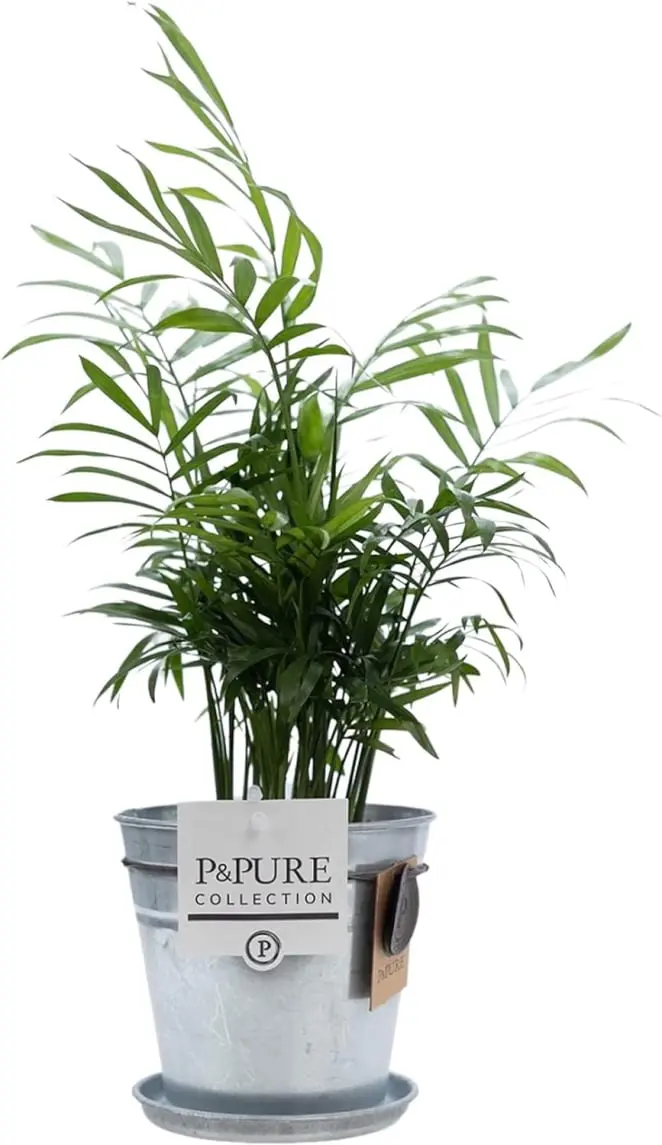
Air-Purifying Qualities: EXCELLENT
Excels at filtering out benzene and trichloroethylene.
Care: WEEKLY
Prefers bright, indirect light and needs to be watered when the soil feels dry to the touch.
The Bamboo Palm, known scientifically as Chamaedorea seifrizii, is a tropical palm valued for its air-purifying qualities and attractive, bamboo-like stems. It's a popular indoor plant due to its ease of care and ability to bring a touch of the tropics to any living space.
Light Requirements: Bamboo Palms prefer bright, indirect light but can tolerate lower light conditions, making them suitable for a variety of indoor settings. Direct sunlight should be avoided, as it can scorch the leaves.
Watering: These palms like their soil to be consistently moist but not waterlogged. Water the plant when the top inch of soil feels dry to the touch. Overwatering can lead to root rot, so it’s important to ensure good drainage. Reduce watering in the winter when the plant’s growth slows down.
Soil and Potting: Use a well-draining potting mix. A standard houseplant mix with some added perlite or sand for improved drainage works well. Repotting every few years or when the plant becomes root-bound is recommended. Ensure the new pot has drainage holes to prevent excess water accumulation.
Temperature and Humidity: Bamboo Palms thrive in typical room temperatures (65-75°F or 18-24°C) and do not tolerate cold drafts or temperatures below 55°F (13°C). They prefer higher humidity but can adapt to average home humidity levels. If the air is too dry, the leaf tips may turn brown. Increase humidity by misting the leaves, using a humidifier, or placing a tray of water near the plant.
Fertilizing: Fertilize the Bamboo Palm with a diluted, balanced fertilizer during the growing season (spring and summer). Avoid over-fertilizing, which can damage the plant.
Pruning and Maintenance: Prune any brown or yellowing fronds to keep the plant looking tidy and healthy. Regularly dusting the leaves will also help the plant absorb more light and improve its overall appearance.
Air Purifying: Bamboo Palms are known for their ability to filter indoor air pollutants, making them a great choice for improving indoor air quality.
General Care Tips: This palm is relatively low-maintenance but does require consistent care to thrive. It’s less susceptible to pests compared to other houseplants but keep an eye out for common issues like spider mites or scale insects.
In summary, the Bamboo Palm is an excellent choice for those seeking a low-maintenance, air-purifying plant that can add a lush, tropical feel to their indoor environment. Its adaptability to various light conditions and relative ease of care make it a popular choice for both home and office settings.

Air-Purifying Qualities: EXCELLENT
Known for reducing airborne fecal particles and filtering out formaldehyde.
Care: EASY -
Needs moderate exposure to sunlight and slightly moist soil. Can be grown as a hanging or floor plant.
English Ivy, scientifically known as Hedera helix, is a classic and versatile houseplant, celebrated for its lush foliage and excellent air-purifying capabilities. Its trailing vines and adaptable nature make it a popular choice for hanging baskets, shelves, or as a ground cover in container gardens.
Light Requirements: English Ivy prefers bright, indirect light but can also adapt to medium and low light conditions. Avoid exposing it to direct, harsh sunlight, as this can scorch the leaves. The variegated varieties of English Ivy may require more light to maintain their distinctive patterns.
Watering: Water English Ivy when the topsoil becomes dry to the touch, typically every 7 to 10 days. It’s important to avoid overwatering, as this can lead to root rot. In winter, reduce watering as the plant’s growth slows down.
Soil and Potting: A well-draining potting mix is ideal for English Ivy. Ensure the pot has adequate drainage holes to prevent water accumulation. Repotting every few years or when the plant becomes root-bound can help maintain its health and vigor.
Temperature and Humidity: English Ivy thrives in cool to average room temperatures, around 60-75°F (15-24°C). It prefers a humid environment, so consider misting the leaves regularly or using a humidifier, especially in dry conditions.
Fertilizing: Fertilize the plant with a balanced, liquid fertilizer once a month during the growing season (spring through fall). Reduce fertilization in the winter months.
Pruning and Maintenance: Regular pruning helps maintain its shape and encourages fuller growth. Trimming back the vines also prevents the plant from becoming too leggy.
Air Purifying: English Ivy is particularly adept at removing airborne toxins such as formaldehyde, making it a beneficial plant for indoor air quality.
Toxicity: It's important to note that English Ivy is toxic to pets and humans if ingested, so it should be kept out of reach of children and animals.
Pest Control: Watch out for pests like spider mites, aphids, and mealybugs. Regularly inspecting the plant and maintaining proper care can help prevent infestations.
In summary, English Ivy is a charming and practical choice for those looking to enhance their indoor space with a plant that is both aesthetically pleasing and beneficial for air quality. Its ability to adapt to various light conditions and relatively easy care requirements make it a favorite among plant enthusiasts.
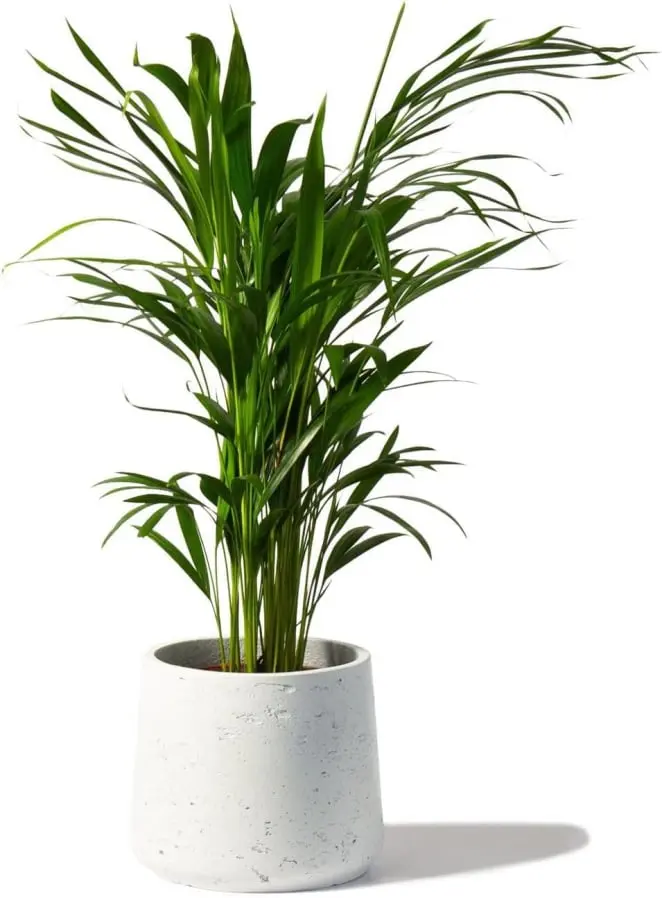
Air-Purifying Qualities: EXCELLENT
Effective in removing toxins and excellent for humidifying indoor air.
Care: WEEKLY
Prefers bright, indirect light and needs regular watering.
The Areca Palm, also known as Dypsis lutescens or the Butterfly Palm, is a popular indoor palm cherished for its elegant, feathery fronds and air-purifying qualities. Native to Madagascar, it's often used in interior decoration for its tropical appearance and ability to bring a sense of serenity and nature indoors.
Light Requirements: Areca Palms prefer bright, indirect light. They can tolerate lower light levels, but insufficient light may lead to leggy growth and yellowing fronds. Direct sunlight, especially in hot climates, can scorch the leaves, so it’s best to avoid placing the plant in direct sun for extended periods.
Watering: The soil should be kept evenly moist but not waterlogged. Water the plant when the top inch of soil feels dry. Overwatering or allowing the plant to sit in standing water can lead to root rot. In winter, reduce watering as the plant's growth slows down.
Soil and Potting: A well-draining potting mix is ideal, such as one formulated for palms or cacti and succulents. Ensure the pot has drainage holes to prevent excess water accumulation. Repotting is typically needed every couple of years or when the plant becomes root-bound.
Temperature and Humidity: Areca Palms enjoy warm, humid environments. They thrive in temperatures between 65-75°F (18-24°C) but can tolerate a range from 55-85°F (13-29°C). These palms prefer higher humidity and may benefit from regular misting or a humidifier, especially in dry indoor environments.
Fertilizing: Fertilize with a balanced, water-soluble fertilizer during the growing season (spring and summer), reducing the frequency in the fall and winter. Be cautious not to over-fertilize, as this can damage the plant.
Pruning and Maintenance: Prune any yellow or dead fronds to keep the plant looking tidy and healthy. Dust the leaves regularly to ensure the plant can photosynthesize efficiently.
Air Purifying: The Areca Palm is noted for its ability to purify indoor air by removing toxins and producing oxygen, making it a healthy addition to any home or office.
General Care Tips: This palm is relatively easy to care for, but it’s sensitive to fluoride and other chemicals often found in tap water. Using filtered or rainwater can prevent tip burn on the leaves.
In summary, the Areca Palm is a graceful and attractive houseplant that not only adds a tropical flair to indoor spaces but also benefits indoor air quality. Its care needs are straightforward, making it suitable for both novice and experienced plant enthusiasts. With proper care, it can become a lush, green focal point in any room.
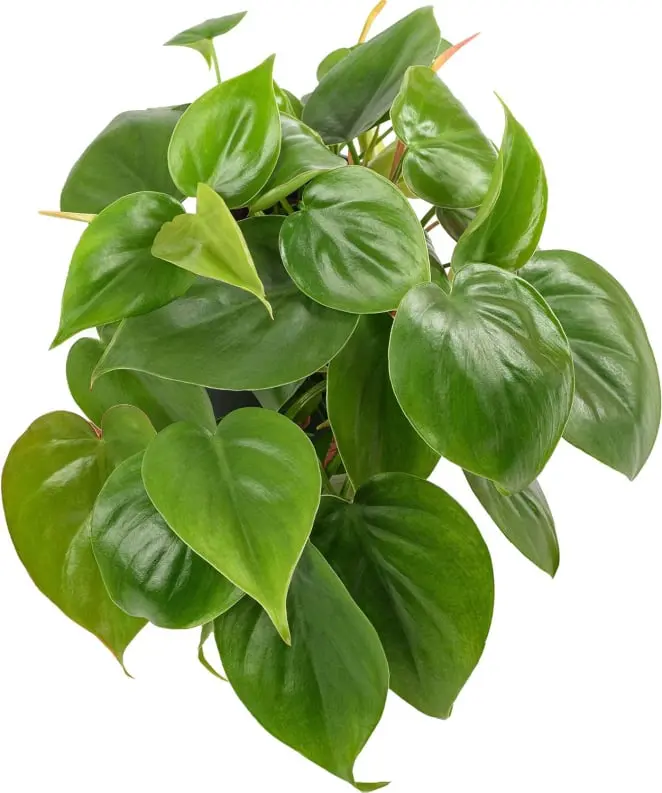
Air-Purifying Qualities: EXCELLENT
Particularly good at absorbing formaldehyde.
Care: WEEKLY
Easy to care for; prefers moderate light and regular watering. Note that it is toxic to pets and children if ingested.
The Philodendron is a diverse genus of indoor plants, highly regarded for its wide variety of shapes, sizes, and leaf patterns. This plant is a favorite among houseplant enthusiasts due to its striking appearance and relatively easy care. Philodendrons are known for their lush, green leaves, and some species have heart-shaped or split leaves that add to their appeal.
Light Requirements: Philodendrons generally prefer bright, indirect light. They can tolerate lower light levels, but insufficient light may lead to leggy growth and smaller leaves. Variegated varieties may require more light to maintain their unique patterns. Direct sunlight can scorch their leaves, so it's best to avoid placing them in direct sun.
Watering: Water your Philodendron when the top inch of soil feels dry. They prefer the soil to be consistently moist but not waterlogged. Overwatering can cause root rot, so good drainage is important. In the winter, reduce watering as the plant's growth slows.
Soil and Potting: Use a well-draining potting mix. A mixture containing peat, perlite, and pine bark is often suitable. Philodendrons should be repotted every 1-2 years, or when they become root-bound. Ensure the new pot has drainage holes.
Temperature and Humidity: Philodendrons thrive in warm, humid environments typical of their tropical origins. They prefer temperatures between 65-75°F (18-24°C) but can tolerate a range from 60-85°F (15-29°C). Higher humidity levels can promote lush growth and larger leaves.
Fertilizing: Fertilize your Philodendron every 4-6 weeks during the growing season with a balanced, water-soluble fertilizer. Reduce feeding in the fall and winter when growth slows.
Pruning and Maintenance: Pruning is not typically required but can be done to control size or remove any yellow or damaged leaves. Cleaning the leaves with a damp cloth can help the plant photosynthesize more efficiently.
Air Purifying: Like many indoor plants, Philodendrons are known to purify the air by removing toxins such as formaldehyde, making them a healthy addition to indoor spaces.
Toxicity: It's important to note that Philodendrons are toxic to pets and humans if ingested, so keep them out of reach.
General Care Tips: Philodendrons are relatively easy to care for, making them ideal for beginners. They are adaptable to various indoor conditions and can thrive with basic care and attention.
In summary, the Philodendron is an excellent choice for indoor gardeners looking for a plant with both visual appeal and ease of care. Its ability to adapt to various indoor environments and its air-purifying qualities make it a popular and rewarding houseplant.
Indoor plants are a fantastic at boosting the atmosphere with some greenery into your property and improve the air quality. However, it is critical to attend to them well with a view to preserve them and keep them healthy and as with all living thing in our care. In this article, we can provide guidelines and hints for caring for indoor flora, along with regular care.
Choosing the Right Plant for Your Home
Before you begin worrying for indoor plants, it is essential to select the right plant for your home or office. Some plant life require more daylight or humidity than others, so it's crucial to choose a plant with a view to thrive within the situations of your home. Some easy-to-care-for flora for beginners consist of pothos, snake plant, and ZZ plant.
Watering
One of the most crucial aspects of being concerned for indoor plants is watering. Overwatering or underwatering may be unfavourable to your plant life. It's important to water your plants regularly however no longer too frequently. Most indoor plants need a watering once a week, but this could vary relying on the plant and the conditions in your home. To test in case your plant desires water, stick your finger in the soil. If the top inch of soil is dry, it is time to water or if the soil sticks to your finger its ok to leave it for a couple more days.
Light
Indoor plants need light to grow, but not all plants require the direct light. Some flora, like succulents and cacti, decide on shiny, direct sunlight, even as others, like snake flowers and pothos, can tolerate low light. If your plant isn't always getting enough light, it's going to start to wilt and lose its leaves. If it's getting too much light, the leaves may additionally become scorched. Make positive to area your plants in a spot that receives the right amount of mild for his or her desires.
Humidity
Indoor vegetation additionally want the proper amount of humidity to thrive. Some flora, like ferns and orchids, require excessive humidity, whilst others, like succulents, prefer drier conditions. You can increase the humidity around your vegetation by means of misting them with water or placing a tray of water near them. If your property is mainly dry, you can additionally invest in a humidifier.
Soil
The soil your indoor vegetation are planted in is likewise important. Most indoor flora prefer properly-draining soil that is rich in nutrients. Make positive to pick a soil mix it truly is suitable for the form of plant you are being concerned for. You also can upload fertilizer to the soil to provide your plants a boost of vitamins.
Pests
Indoor flowers may be at risk of pests like spider mites, mealybugs, and scale bugs. If you note any pests on your flowers, it is crucial to take action right away. You can use insecticidal cleaning soap or neem oil to take away pests. You can also save you pests by maintaining your vegetation easy and dirt-free.
Everyday Care
In addition to the above hints, there are some ordinary care pointers you must maintain in mind when being concerned for indoor plant life. These include:
Dusting your plant life frequently to maintain them clean and free of debris
Checking your plants for any symptoms of harm or ailment
Repotting your plant life after they outgrow their bins
Pruning your flowers to promote increase and dispose of any useless or damaged leaves
Keeping your plants faraway from drafts and excessive temperatures